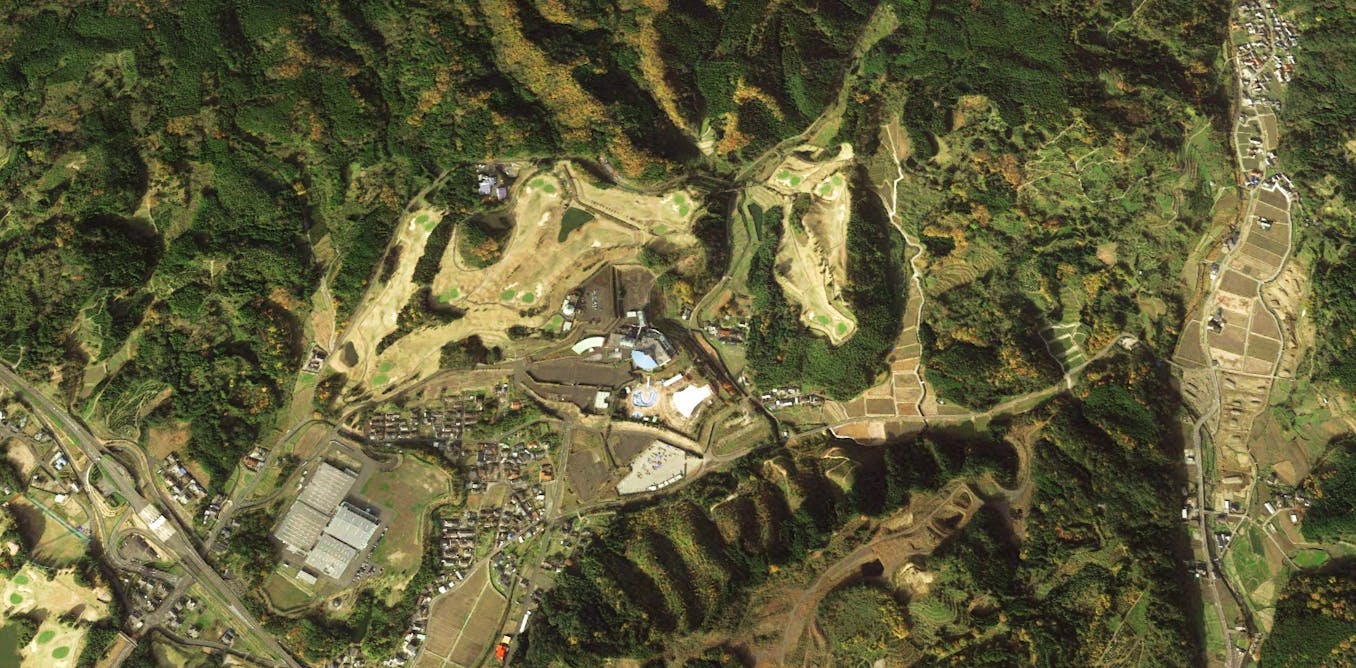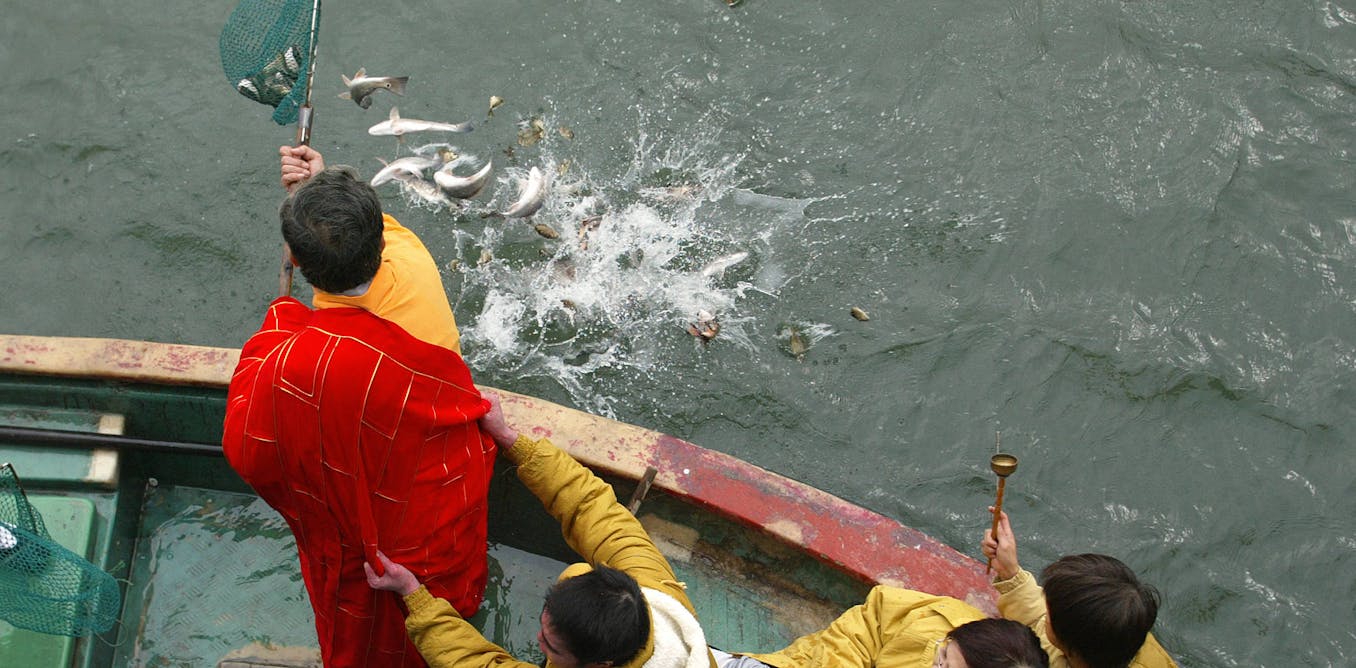The video “SCAPHISM – THE WORST TORTURE METHOD OF THE PERSIAN EMPIRE” delves into the dark and chilling world of ancient Persian punitive practices, specifically focusing on the gruesome method of scaphism. This method of torture, also known as the boats, was reserved for the most despised criminals and enemies, instilling dread and fear in those who heard of its horrors.
Scaphism involved immobilizing the victim between two hollowed-out boats or in a box with holes for their head, hands, and feet. The victim was then forced to ingest a mixture of milk and honey, leading to severe diarrhea, while honey was applied to attract insects to their flesh. Left under the scorching sun, the victim’s body quickly became a breeding ground for flies and other vermin, slowly eating them alive.
The article dives deep into the psychological torment inflicted by scaphism, highlighting the Persian Empire’s utilization of extreme measures to maintain control and authority. It also reflects on the enduring fascination with human cruelty and the resilience of the human spirit in the face of unimaginable torment.
Ultimately, the video sheds light on the dark depths to which humanity can sink in its quest for dominance and retribution, serving as a grim reminder of the capacity for cruelty throughout history. As we explore ancient punitive practices, we gain insight into the mechanisms of power, control, and the enduring strength of the human will to survive.
Watch the video by Top Discovery
Video Transcript
Venture into the shadows of History where the ancient Persian Empire’s formidable might was matched by its chilling punitive practices uncover the harrowing Tales of scaff ism a method of torture so gruesome it has echoed Through the Ages are you prepared to explore the depths of human cruelty scaff ISM the atrocious method of
Torture of the Persian Empire in the annals of human cruelty few methods of torture stir as much horror and Fascination as scaff ISM also known as the boats this ancient Persian method of execution was reserved for the most despised criminals and enemies a punishment so brutal that its mere
Mention could quell dissent and Inspire dread but what was scism and why has its Legacy endured for Millennia as a symbol of ultimate suffering scaff ism’s procedure is as intricate as it is horrifying The Condemned was placed between two hollowed out boats or in a single box with holes for the head hands
And feet to protrude this crude vessel then became their final Abode The Prisoner immobilized was forced to ingest a mixture of milk and honey to the point of developing severe diarrhea while more honey was applied to sensitive parts of their body to attract insects left under the scorching Sun the
Victim’s enclosure would quickly become a breeding ground for swarms of flies wasps and other Vermin drawn by the stench of Decay and excrement the psychological torment began with the knowledge of the inevitable slow demise compounded by the physical Agony of being eaten alive as days turned into weeks the victim’s flesh would ulcerate
Becoming a living incubator for the larv of insects the Persians masters of psychological warfare understood that the anticipation of death could be as excruciating as its execution but beyond the physical pain scaf ISM was a public spectacle of power a stark warning that the Empire’s reach could extend into the
Very bodies of its enemies what does this say about ancient Persian society and its views on Justice and Punishment on one hand it showcases a civilization that valued order and Authority above all willing to employ Extreme Measures to maintain control on the other it reflects a universal human
Fascination with the limits of endurance and the Spectre of mortality the process of scism also illustrates the Ancients understanding of the body and its vulnerabilities by exploiting the natural processes of Decay and the behavior of insects the Persians turned nature itself into an instrument of death this methodical
Approach to torture highlights a grim Ingenuity a deep knowledge of the physical world used for dire purposes but why remember scaff ISM today perhaps it serves as a grim reminder of the depths to which Humanity can sink in its quest for dominance and retribution or maybe it fascinates as a testament to
The enduring strength of the human Spirit even in the face of unimaginable torment the victims of scaff ism nameless and long gone still speak to us of the resilience of the human body and the indomitable will to live even in the darkest of times reflecting on scaff ISM
And its place in history also forces us to confront uncomfortable truths about the present the capacity for cruelty is not confined to the ancient past it is a constant Shadow over human history by examining the extremes of ancient Persian punitive practice practices we gain insight into the mechanisms of
Power control and the human capacity for both suffering and inflicting pain impalement a sharp end the chilling practice of impalement a punishment that conjures images of medieval castles and the infamous Vlad the Impaler was not exclusive to the heart of Transylvania nor to the Grim folklore that surrounds it this method
Of execution equally as ancient and terrifying found its place within the Arsenal of punitive measures employed by the Persian Empire but how did the Persians implement this gruesome technique and what does its use reveal about the broader context of punishment and Power in ancient times impalement is a method designed to maximize suffering
And serve as a deterrent through the spectacle of death a sharp stake was inserted through the victim’s body either vertically through the Torso or from the rear to emerge through the mouth or shoulder ensuring a slow and agonizing demise the Persians like Vlad centuries later utilized impalement to instill
Fear and maintain control over their vast Empire demonstrating their power in a visceral and Visually impactful manner the comparison between the Persian application of impalement and its use by Vlad the Impaler however reveals differences in context and intention Vlad III Prince of wakia famously employed impalement as a means of
Psychological Warfare against his enemies notably the ottoman Turks with Tales of forests of the impaled serving to deter and terrify his actions have cemented his legacy as a figure of extreme cruelty and have inspired countless Legends and myths in contrast the Persians used impalement within a legal and cultural framework that was
Complex and multifaceted aimed not just at enemies but at criminals within their own society as well for the Persians impalement was not solely an act of of Terror but also a Judicial punishment reflecting a codified approach to law and order it was reserved for the most severe transgressions such as treason
Espionage or acts that threatened the stability of the state the spectacle of impalement served as a public reminder of the consequences of challenging the authority of the king and the empire in this way the practice was embedded within the Persian social and political fabric a tool of statecraft as much as a
Method of execution the technical aspects of impalement in the Persian Empire also speak to a disturbing attention to detail historical records suggest that the Persians were adept at prolonging the life of the impaled ensuring that death came slowly this required a precise understanding of the human body manipulating the stake to avoid vital
Organs and maximize suffering such knowledge points to a sophisticated albeit maab level of medical understanding among ancient ient Persian executioners faying the ultimate exposure flaying the act of removing the skin from the body ranks among the most brutal and psychologically disturbing forms of punishment ever devised this method of torture and execution utilized
In various forms across different cultures was also adopted by the ancient Persian Empire it served as a stark Testament to the lengths to which human societies have gone to punish transgressors and deter wouldbe offenders through the graphic display of consequences the practice of flaying is
As ancient as it is gruesome to be flate alive was to suffer not just unimaginable physical pain but also the ultimate form of humiliation and dehumanization the skin the largest organ of the human body and the most visible marker of identity was methodically and savagely removed often
While the victim was still alive this process was not only a death sentence but also a message a spectacle designed to instill Terror in the hearts of those who witnessed it or heard tals of its execution in the Persian Empire faying was reserved for the most egregious of
Offenses it was a punishment that went beyond the individual serving as a grim warning of the Empire’s power and the severe consequences of Defiance the Persians known for their sophisticated systems of administration and Justice employed flaying as a tool within their complex legal and social order it was a
Statement of control a demonstration that the Empire could strip away not just one’s life but also one’s very Humanity historically the practice of flaying could also have symbolic significance in removing the skin the executioners Stripped Away the victim’s identity reducing them to an object lesson in the power of the state and the
Futility of resistance the flade skin could be displayed played publicly a tangible and horrifying reminder of the price of transgression against the Persian authorities this act of display served not just as a punishment but as a form of political communication reinforcing the social order and the absolute authority of the
King crucifixion a cross-cultural method of execution crucifixion often associated with the Roman Empire and the execution of Jesus Christ has a history that spans cultures continents and Millennia this form of execution involving the nailing or binding of a person to a cross or similar structure was also employed by
The ancient Persians among others as a method of punishment and public deterrent the adoption and adaptation of crucifixion by the Persians highlight its Effectiveness as a tool of control and its symbolic representation of ultimate subjugation in the Persian context crucifixion was more than a mere method me of execution it was a spectacle
Designed to convey the might of the Empire and the futility of rebellion the Persians much like the Romans utilized crucifixion to punish traitors criminals and enemies of the state displaying the crucified in public spaces as a warning to all who might dare to challenge the established order this form of execution
Was particularly favored for its prolonged nature ensuring that The Condemned suffered a slow and agonizing death visible to all the historical roots of crucifixion Trace back even further than the Persian Empire with evidence suggesting its use in various ancient civilizations including the Assyrians and Babylonians the Persians renowned for their military prowess and
Administrative Acumen integrated crucifixion into their judicial system from these earlier practices adapting it to fit their own societal norms and legal Frameworks this adaptation underscores the fluid nature of punitive methods across cultures shaped by the demands of governance the need for deterrence and the influence of Intercultural exchanges crucifixions Effectiveness as
A deterrent stemmed not only from the physical pain inflicted but also from the social and spiritual stigma attached to it to be crucified was to be displayed in a state of vulnerability and defeat stripped of dignity and subjected to the ele ments and the scorn of passers by for the Persians this
Public humiliation was an integral aspect of the punishment serving to reinforce the authority of the king and the state over the individual wheel breaking the circle of pain wheel breaking also known as the Catherine wheel was one of the most brutal forms of capital punishment practiced in medieval and early modern
Europe This method of execution not only served as a means to inflict a prolonged and agonizing death but also acted as a grim spectacle of deterrence embodying the societal and judicial extremities of the time the process steeped in a maob theatricality underscores a period when the boundaries between punishment and
Public spectacle were indistinct and the infliction of pain was meticulously calibrated the wheel breaking procedure commenced with The Condemned being tied to a large wooden wheel the limbs sped along the spokes the Executioner then shattered Ed the victim’s limbs with a heavy iron cudel or Hammer breaking them
In multiple places this act of breaking was not merely physical but symbolically broke the person rendering them less than human in the eyes of society the wheel was then hoisted onto a tall pole with the mutilated victim left to die from their injuries dehydration or exposure in some instances to hasten
Death or as a final Mercy the Executioner would deliver a Cuda grass striking a fatal blow to the chest or head this method of execution was reserved for the most heinous crimes perceived as a fate worse than death the psychological impact on both the victim and The Spectators was profound for The
Condemned the anticipation of the pain the public humiliation and the slow inexorable March towards death constituted a torture in itself for The Spectators the spectacle was a visceral reminder of the consequences of transgressing societal norms and the absolute power of the judicial system the spectacle of wheel breaking
Served multiple functions it was a method of punishment a deterrent and a form of social control reinforcing the authority of the state and the legal system the societal implications of wheel breaking were significant it reflected a Judicial philosophy that equated the severity of punishment with the gravity of the crime believing that
The spectacle of of suffering would deter others from Criminal Behavior this form of execution was a public Affair attended by the community and often carried out in marketplaces or on hillsides for maximum visibility it was a part of the Civic calendar a gruesome ritual that reinforced communal norms and values through the spectacle
Of punishment cage suspension hanging in the balance cage suspension a method of punishment that seems almost medieval in its cruelty and spectacle was not merely a means of executing The Condemned but also served as a potent symbol of deterrence and societal control this form of punishment involved confining
The individual in a cage or jibbit which was then hung from a Gallows or a prominent location often at the crossroads the entrance to a city or in a Public Square The Condemned were left to die a slow agonizing death from exposure thirst or starvation their bodies displayed as a stark warning to
Others the psychological torment for those sentenced to cage suspension began well before their physical suffering the knowledge that their final days would be spent in excruciating discomfort subject to the elements and the Gaze of passor by was part of the punishment for the society that enforced such measures the
Spectacle served as a grim reminder of the consequences of transgressing the law it reinforced the authority of the state and the Judiciary demonstrating their power not only to take life but to prolong suffering the process of cage suspension varied slightly from region to region but the underlying intention remained consistent to maximize the
Visibility of the punishment and by extension its deterrent effect the cages were often designed to be just large enough to prevent the occupant from finding a comfortable position exacerbating their physical distress in some instances The Condemned were placed alive in the cages while in others the
Cage served as a jibit for the display of the body after execution by other means the societal implications of cage suspension were profound it was a public spectacle that involved the entire Community not just as passive Spectators but as active participants in the administration of justice the presence
Of the cages in public spaces served as a constant tangible reminder of the bound boundaries of acceptable behavior and the consequences of Crossing those boundaries live burial buried secrets of the Persian Empire live burial a method of execution shrouded in Terror and finality stands as one of the most psychologically
Harrowing forms of capital punishment ever conceived this ancient practice utilized sparingly yet significantly within the Persian Empire represents a chilling intersection of punishment fear and the absolute power of the state the act of burying someone alive strips away the very essence of humanity reducing an individual to the most Primal state of
Helplessness and despair the Persian Empire renowned for its vast expanse and sophisticated system of governance occasionally resorted to live burial as a means of enforcing its legal and moral codes this form of execution was reserved for the most heinous offenses those considered so egregious that mere death was deemed
An insufficient penalty the practice served multiple purposes it was a deterrent a tool for social control and a symbolic act that reinforced the supremacy of the king’s law live burial inflicted not just a physical death but a profound psychological Terror The Condemned aware of their impending doom faced a solitary and agonizing end
Deprived of light air and human contact this method of execution tapped into Universal fears of Darkness confinement and abandonment making it a powerful instrument of psychological warfare against potential transgressors the societal implications of live burial were profound it demonstrated the lengths to which the state would go to maintain order and
Discipline within its ranks the Spectre of live burial loomed as an ultimate threat a grim reminder of the Fate that awaited those who dared to defy the Empire’s edicts by invoking such a fear the Persian Empire fortified its Authority and deterred not just criminal acts but any form of dissent or
Rebellion the Brazen bull a borrowed horror the Brazen bull an appalling instrument of torture and execution epitomizes the lengths to which human cruelty can extend originating from ancient Greece this device was a hollow bronze statue in the shape of a bull within which victims were placed and
Subjected to a fiery death the heat turned the metal scorching hot roasting the victim inside this horrifying method of execution was not only a testament to the Ingenuity of ancient societies but also to their capacity for brutality while primarily associated with Greek history the concept of such a gruesome execution method possibly found
Its way to Persia illustrating the complex web of cultural exchange that characterized the ancient world the potential use of the Brazen Bull in Persia or adaptations inspired by it highlights the transmission of ideas including those related to punishment and torture across civilizations ancient societies were interconnected through trade Warfare and
Diplomacy facilitating the spread of technological innovations philosophical Concepts and in this dark instance methods of execution the Persians known for their advanced administrative systems military prowess and Architectural achievements also engaged in this exchange of knowledge which may have included the Grim apparatus of the Brazen bull in the context of Persian
Justice the adoption or adaptation of the Brazen bull would signify more than a mere method of execution it would embody the ultimate display of power and control the Persians like the Greeks before them utilized severe punishments not only to eliminate threats but also to deter future transgressions through
The spectacle of suffering the Brazen Bull with its dual function as an instrument of death and a means of public Terror fits neatly into this Paradigm its use or even the threat of its use would have served as a potent reminder of the consequences of defying the Empire’s Authority the psychological
Impact of such a device cannot be overstated for The Condemned the anticipation of death in in such a horrific manner would be a torture in itself for the public the spectacle of the Brazen bull complete with the agonized screams of the victim transformed by the devices Acoustics
Into the bellowing of a bull would leave an indelible mark on the collective psyche this blend of physical torture and psychological Terror was designed to reinforce societal norms and the supremacy of the state over the individual water torture drips of despair water torture a method of inflicting pain and suffering with deceptive
Simplicity has been utilized in various forms across different cultures and eras its application ranges from the seemingly benign Act of dripping water onto a person’s forehead to the forced ingestion of water to the point of pain or even death the essence of water torture lies not in the use of complex
Machinery or elaborate setups but in its ability to turn a basic element of life into a a tool of Torment this chapter explores the variance of water torture highlighting the profound psychological and physical anguish it can cause over time one of the most Insidious forms of water torture is known as Chinese water
Torture where water is slowly dripped onto a victim’s forehead for an extended period this method exploits the human body’s response to repetitive stimuli transforming the sensation of water droplets which are initially harmless and painless into a source of extreme mental anguish the anticipation of each drop and the inability to stop them or
Predict their timing creates a psychological burden that can break down the strongest Wills demonstrating the immense power of psychological over physical pain another variant involves the forced ingestion of water known as water cure or water boarding in its more modern Incarnation this method simulates the sensation of drowning triggering an
Innate fear of Suffocation victims are bound and water is poured over their face into their breathing passages creating a terrifying experience of drowning while remaining alive this technique causes physical suffering and mental trauma exploiting the body’s Panic response to the threat of drowning the Simplicity of water torture is what makes it particularly
Nefarious water an element essential for life becomes a vector for suffering its accessibility meant that water torture could be employed with little preparation or resources making it a favored technique for interrogators and torturers throughout history the physical effects ranging from skin irritation in the case of dripping water
To the risk of water intoxication or damage to the lungs in forced ingestion scenarios are compounded by the psychological torment of enduring an ordeal that transforms a source of sustenance into one of pain burning a fiery fate burning at the stake stands out as one of the most visually dramatic and psychologically
Harrowing methods of execution throughout history utilized across various cultures and epics this form of capital punishment was not only a method to inflict death but also served as a powerful tool of social control and a spectacle of authority the act of burning someone alive Taps into Primal fears of fire and
Pain making it a fate that few could witness without deep emotional impact
Video “SCAPHISM – THE WORST TORTURE METHOD OF THE PERSIAN EMPIRE” was uploaded on 02/06/2024 to Youtube Channel Top Discovery

The post “Scaphism – Video ” by GretAi was published on 03/25/2024 by news.gretai.com



































